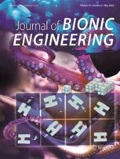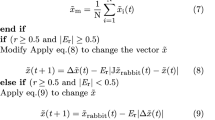Abstract
Multi Access Interference (MAI) is the main source limiting the capacity and quality of the Multiple-Input Multiple-Output Orthogonal Frequency Division Multiplexing (MIMO-OFDM) system which fulfills the demand of high-speed transmission rate and high quality of service for future underwater acoustic (UWA) communication. Multi User Detection (MUD) is needed to overcome the performance degradation caused by MAI. In this research, both local and global optimal solutions are obtained in Bionic Binary Spotted Hyena Optimizer (BBSHO) algorithm using the Position Coordinate Vectors (PCVs) of the social behavior of spotted hyenas to achieve MUD. Further, Extremal Optimization (EO) is introduced in BBSHO algorithm to improve the local search ability within the search space. Hence, a hybrid BBSHO algorithm is proposed for achieving MUD at the receiver of the MIMO-OFDM system whose transceiver model in underwater is implemented using BELLHOP simulation system. By MATLAB simulation, it is shown that the Bit Error Rate (BER) performance of the proposed hybrid algorithm outperforms with best optimal solution within the search space towards MUD for Interference to Noise Ratio (INR) at 10 dB, 20 dB, and 40 dB over conventional detectors and metaheuristic approaches such as Binary Spotted Hyena Optimizer (BSHO), Binary Particle Swarm Optimization (BPSO) in the UWA network.
Similar content being viewed by others
References
Qu F Z, Wang Z D, Yang L Q, Wu Z H. A journey toward modeling and resolving doppler in underwater acoustic communications. IEEE Communications Magazine, 2016, 54, 49–55.
Das B, Subudhi B, Pati B B. Cooperative formation control of autonomous underwater vehicles: An overview. International Journal of Automation and Computing, 2016, 13, 199–225.
Khan M R, Mahapatra S, Das B. UWB Saleh-Valenzuela model for underwater acoustic sensor network. International Journal of Information Technology, 2020, 12, 1073–1083.
Qiao G, Babar Z, Ma Lu, Liu S Z, Wu J Q. MIMO-OFDM underwater acoustic communication systems — A review. Physical Communication, 2017, 23, 56–64.
Khan MR, Das B, Pati B B. Channel estimation strategies for underwater acoustic (UWA) communication: An overview. Journal of the Franklin Institute, 2020, 357, 7229–7265.
Verd S. Minimum probability of error for asynchronous Gaussian multiple-access channels. IEEE Transactions on Information Theory, 1986, 32, 85–96.
Dhiman G, Kumar V. Spotted hyena optimizer: A novel bio-inspired based metaheuristic technique for engineering applications. Advances in Engineering Software, 2017, 114, 48–70.
Panda N, Majhi S K. Improved spotted hyena optimizer with space transformational search for training pi-sigma higher order neural network. Computational Intelligence, 2020, 36, 320–350.
Kumar V, Kaur A. Binary spotted hyena optimizer and its application to feature selection. Journal of Ambient Intelligence and Humanized Computing, 2019, 10, 1–21.
Hung H L, Huang Y F, Wen J H. A particle swarm optimization based multiuser detector for DS-CDMA communication systems. IEEE International Conference on systems, Man, and Cybernetics, Taipei, Taiwan, 2006, 1956–1961.
Guo Z Q, Xiao Y, Lee M H. Multiuser detection based on particle swarm optimization algorithm. IEEE International Symposium on Circuits and Systems, New Orleans, USA, 2007, 2582–2585.
Zhao N, Lv X W, Wu Z. A hybrid ant colony optimization algorithm for optimal multiuser detection in DS-UWB system. Expert Systems with Applications, 2012, 39, 5279–5285.
San-José-Revuelta L M, Arribas J I. Three natural computation methods for joint channel estimation and symbol detection in multiuser communications. Applied Soft Computing, 2016, 49, 561–569.
Larbi N, Debbat F, Stambouli A B. Multiuser detection for DS-CDMA systems using honeybees mating optimization algorithm. Arabian Journal of Science and Engineering, 2014, 39, 4911–1921.
Kumar B S, Kumar K R S. Multiuser detection in MIMO-OFDM wireless communication system using hybrid firefly algorithm. International Journal of Engineering Research & Applications, 2014, 4, 176–183.
Lu H M, Yang G G, Hu F G, Sun D Z. Performance analysis of a multi-user MIMO-OFDM system based on a hybrid genetic algorithm. Journal of Engineering Science and Technology, 2016, 9, 95–102.
Jiang R K, Wang X T, Cao S, Zhao J F, Li X R. Joint compressed sensing and enhanced whale optimization algorithm for pilot allocation in underwater acoustic OFDM systems. IEEE Access, 2019, 7, 95779–95796.
Tuba E, Simian D, Dolicanin E, Jovanovic R, Tuba M. Energy efficient sink placement in wireless sensor networks by brain storm optimization algorithm. 14th International Wireless Communications & Mobile Computing Conference (IWCMC), Limassol, Cyprus, 2018, 718–723.
Qu C G, Gai W D, Zhong M, Zhang J. A novel reinforcement learning based grey wolf optimizer algorithm for unmanned aerial vehicles (UAVs) path planning. Applied soft computing, 2020, 89, 106099.
Sanchez-Ferreira C, Coelho L S, Ayala H V H, Farias M C Q, Llanos C H. Bio-inspired optimization algorithms for real underwater image restoration. Signal Processing Image Communication, 2019, 77, 49–65.
Luo Q F, Li J, Zhou Y Q. Spotted hyena optimizer with lateral inhibition for image matching. Multimedia Tools and Applications, 2019, 78, 1–20.
Dhiman G, Kumar V. Multi-objective spotted hyena optimizer: a multi-objective optimization algorithm for engineering problems. Knowledge Based Systems, 2018, 150, 175–197.
Dhiman G, Kaur A. A hybrid algorithm based on particle swarm and spotted hyena optimizer for global optimization. Soft Computing for Problem Solving, 2019, 816, 599–615.
Zhang Y J, Lataief K B. An efficient resource allocation scheme for spatial multiuser access in MIMO/OFDM systems. IEEE Transactions on Communications, 2005, 53, 107–116.
Boettcher S, Percus A G. Extremal optimization: An evolutionary local-search algorithm. In: Bhargava H K and Ye N eds., Computational Modelling and Problem Solving in the Networked World, 2003, 21, 61–77.
Author information
Authors and Affiliations
Corresponding author
Rights and permissions
About this article
Cite this article
Khan, M.R., Das, B. Multiuser Detection for MIMO-OFDM system in Underwater Communication Using a Hybrid Bionic Binary Spotted Hyena Optimizer. J Bionic Eng 18, 462–472 (2021). https://doi.org/10.1007/s42235-021-0018-y
Published:
Issue Date:
DOI: https://doi.org/10.1007/s42235-021-0018-y




